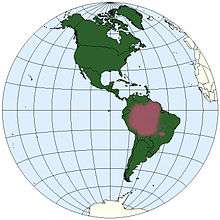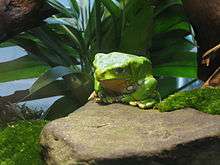Phyllomedusa bicolor
| Phyllomedusa bicolor | |
|---|---|
 | |
| Scientific classification | |
| Kingdom: | Animalia |
| Phylum: | Chordata |
| Class: | Amphibia |
| Order: | Anura |
| Family: | Hylidae |
| Subfamily: | Phyllomedusinae |
| Genus: | Phyllomedusa |
| Species: | P. bicolor |
| Binomial name | |
| Phyllomedusa bicolor (Boddaert, 1772) | |
 | |
| Synonyms | |
|
Rana bicolor Boddaert, 1772 | |
Phyllomedusa bicolor, also known as blue-and-yellow frog, bicoloured tree-frog, giant monkey frog,[2] giant leaf frog,[3] or waxy-monkey treefrog,[4] is a hylid frog. It is found in the Amazon basin as well as some surrounding areas.[2]
Description
Males measure 91–103 mm (3.6–4.1 in) and females 111–119 mm (4.4–4.7 in) in snout–vent length. The dorsum is dark green whereas the belly is white to yellow-white or cream. Lower lips, chest and front legs bear sparse white spots with dark frames; these are more dense on the flanks and hind legs. Fingers are transparent brown and have large, green adhesive discs. There is a prominent gland extending from behind the eye over the tympanum. The iris is dark gray.[4]
Distribution
It is found throughout the Amazon Rain forest of northern Bolivia, western and northern Brazil, southeastern Colombia, eastern Peru, southern and eastern Venezuela, and the Guianas. Occasionally, it is also found in the riparian forest area of the Cerrado, a vast tropical savanna ecoregion of Brazil.[1]
Habitat and behaviour

Phyllomedusa bicolor is a nocturnal, arboreal frog. Males call from trees in tropical humid forests. Female and male construct a leaf-nest above forest pools. When the eggs hatch from these nests, the tadpoles fall into the water, where they continue the development into adult frogs. Peak reproduction occurs during the rainy season.[4]
Conservation
The IUCN endangered species database lists them in the "Least Concern" category, in view of their current wide distribution and large population.[1]
Medicinal use
The skin secretion of the frog contains deltorphin, deltorphin I, deltorphin II and dermorphin.[5][6][7]
References
- 1 2 3 Claudia Azevedo-Ramos; Enrique La Marca (2010). "Phyllomedusa bicolor". IUCN Red List of Threatened Species. Version 2015.2. International Union for Conservation of Nature. Retrieved 25 August 2015.
- 1 2 Frost, Darrel R. (2015). "Phyllomedusa bicolor (Boddaert, 1772)". Amphibian Species of the World: an Online Reference. Version 6.0. American Museum of Natural History. Retrieved 25 August 2015.
- ↑ "Phyllomedusa bicolor Giant Leaf Frog". Encyclopedia of Life. Retrieved 25 August 2015.
- 1 2 3 "Phyllomedusa bicolor". AmphibiaWeb: Information on amphibian biology and conservation. [web application]. Berkeley, California: AmphibiaWeb. 2015. Retrieved 25 August 2015.
- ↑ Erspamer V, Melchiorri P, Falconieri-Erspamer G, et al. (July 1989). "Deltorphins: a family of naturally occurring peptides with high affinity and selectivity for delta opioid binding sites". Proceedings of the National Academy of Sciences of the United States of America. 86 (13): 5188–92. doi:10.1073/pnas.86.13.5188. PMC 297583
 . PMID 2544892.
. PMID 2544892. - ↑ Melchiorri P, Negri L (1996). "The dermorphin peptide family". General Pharmacology: The Vascular System. 27 (7): 1099–107. doi:10.1016/0306-3623(95)02149-3. PMID 8981054.
- ↑ Amiche M, Delfour A, Nicolas P (1998). "Opioid peptides from frog skin". EXS. 85: 57–71. doi:10.1007/978-3-0348-8837-0_4. PMID 9949868.
External links
| Wikimedia Commons has media related to Phyllomedusa bicolor. |
- Vice Magazine - The Sapo Diaries
- Mariri Magazine - Kampú - Taking the Frog Vaccine
- Mariri Magazine - Frog Sweat ~ Matses Rainforest Medicine
- Erowid -> Phyllomedusa bicolor vault
- Frog secretions and hunting magic in the upper Amazon
